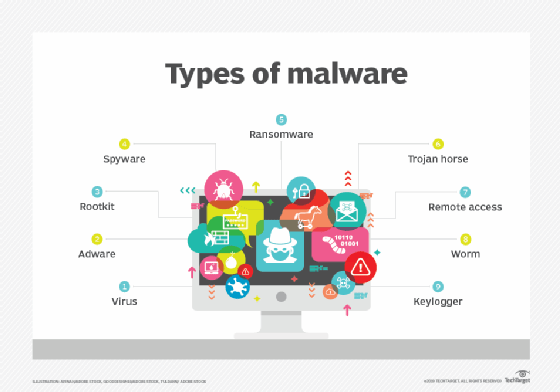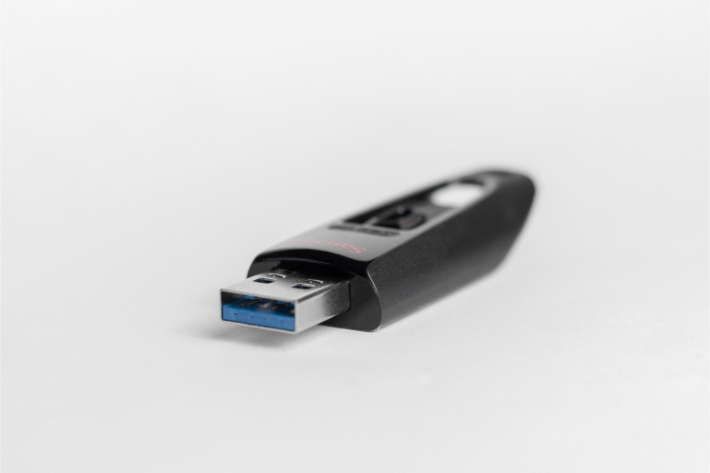Malware
It is a kind of malicious program, file or anything which produces damage on a computer or any other device.
Malware includes many other categories such as Trojan horses, viruses or worms and spyware.
Not all malware is a virus, but all viruses are malware.
Not all malware is a virus, but all viruses are malware.
What job Malware has done?
Malware authors have using technologies to spread their malicious code. An example of this device could be a printer or USB. Hackers could send a malicious code into document format which is download via printer and can be easily spread to other devices such as computers or phones which are a link to these infected devices. An example could be rent printers, which is a high risk as that printers could be infected.
Some malware is more aggressive, which allows authors to communicate with the sources that were infected, which is called command and control.
The common types of malware are presented in the picture, expose below.

Rouse, M (2020).What is Malware?
In 2014 Lenovo ha preinstalled software called Super fish visual search, which was designed to prevent users from a potential attack, when the user opens and login at any browser or web page, the software engaged to. Thus, it software hijacks the user's computers, recording users' data. Such us of this consumer must be informed by the companies if they have pre-installed any kind of software which could violate users' privacy.
According to Anglim. et. al. (2016), most computer users are not protected by law.
Governments should be aware of the damage malware can do and implement rules in those ways, that authors of attacks will be discouraged to commit any further cybercrime.
In 2019 has been reported by IBM X-Force Incident Response and Intelligence Services (IRIS) a total cost of 200 $ million dollars and lose 12000 devices in malware attacks.
The manufacturing industry was targeted by half of the destructive malware cases; other common targets were in the education or oil and gas sectors. Most of the X-Force IRIS team attacks identified targeted victim organizations in the USA, Europe, and the Middle East (Sheridan, 2019).
A malware attack can start via a phishing email, credential stuffing or watering hole attack.
Once inside, attackers can lift passwords and poke around until they have access to the administration. Researchers who have found attackers are often present for weeks or months on a computer, asset, or network before beginning a destructive malware attack. Dark reading has posted on their web, that X-Force IRIS to remediate an incident, takes around from some hundreds to thousands of hours.
One of the most notorious malware is ''WannaCry''.
WannaCry is an example of crypto-ransomware, a form of malware that cybercriminals use to extortion money. Ransomware as WannaCry comes under encrypting files or can lock the computer becoming inaccessible.WannaCry attacks computers as an operating system, using Microsoft Windows. It encrypts data and requests a ransom payment for its return in the Bitcoin crypto-currency.
The WannaCry ransomware attack launched in May 2017 was a global epidemic. This ransomware attack spread through Microsoft Windows operating computers. User files were held hostage, and they demanded a Bitcoin ransom for their return. The damage caused by this attack could have been prevented if not for the continued use of obsolete computer systems and poor education about the need to upgrade software.
The authors of the attack have used a weakness that has been found in the Windows operating system which was developed by the United States National Security Agency.
This breach in the operating system takes place due to the irresponsibility of many users that not update their system, although Microsoft deploys updates for windows security.
Kaspersky has stated for each infected computer, the user had to pay a claim of approximately $ 300 which increased considerably up to $ 600. Also, hackers allot just three days for payment after that the computer system is cracked forever without any change to recover any documents.
Researchers have found if users pay this amount, they will get control over their computers, but rather they will run out of money. Kaspersky said, when victims paid their ransom, there was no way the perpetrators could connect the payment with the machine of a specific victim. Also, Kaspersky recommended not pay a Ransome if the user experiments a Ransome attack.
Statistic WannaCry damaged around 230000 computers. Furthermore, this attack affected company such as Spanish mobile company, Telefonica, and also NHS hospital and surgery from the UK. NHS estimated a cost of 92 million pounds. The financial impact worldwide estimated is around 4 billion dollars.
Kaspersky recommends some actions doing to prevent computer infection.

Anglim, C, Nobahar, G, & Kirtley, JE 2016, Privacy Rights in the Digital Age, Grey House Publishing, Amenia. Available from: ProQuest Ebook Central. [19 Feb 2020].
Kaspersky.co.uk. (2020).What is WannaCry ransomware? [online] Available at: https://www.kaspersky.co.uk/resource-center/threats/ransomware-wannacry [Accessed 9 Feb. 2020].
In 2014 Lenovo ha preinstalled software called Super fish visual search, which was designed to prevent users from a potential attack, when the user opens and login at any browser or web page, the software engaged to. Thus, it software hijacks the user's computers, recording users' data. Such us of this consumer must be informed by the companies if they have pre-installed any kind of software which could violate users' privacy.
According to Anglim. et. al. (2016), most computer users are not protected by law.
Governments should be aware of the damage malware can do and implement rules in those ways, that authors of attacks will be discouraged to commit any further cybercrime.
In 2019 has been reported by IBM X-Force Incident Response and Intelligence Services (IRIS) a total cost of 200 $ million dollars and lose 12000 devices in malware attacks.
The manufacturing industry was targeted by half of the destructive malware cases; other common targets were in the education or oil and gas sectors. Most of the X-Force IRIS team attacks identified targeted victim organizations in the USA, Europe, and the Middle East (Sheridan, 2019).
A malware attack can start via a phishing email, credential stuffing or watering hole attack.
Once inside, attackers can lift passwords and poke around until they have access to the administration. Researchers who have found attackers are often present for weeks or months on a computer, asset, or network before beginning a destructive malware attack. Dark reading has posted on their web, that X-Force IRIS to remediate an incident, takes around from some hundreds to thousands of hours.
One of the most notorious malware is ''WannaCry''.
WannaCry is an example of crypto-ransomware, a form of malware that cybercriminals use to extortion money. Ransomware as WannaCry comes under encrypting files or can lock the computer becoming inaccessible.WannaCry attacks computers as an operating system, using Microsoft Windows. It encrypts data and requests a ransom payment for its return in the Bitcoin crypto-currency.
The WannaCry ransomware attack launched in May 2017 was a global epidemic. This ransomware attack spread through Microsoft Windows operating computers. User files were held hostage, and they demanded a Bitcoin ransom for their return. The damage caused by this attack could have been prevented if not for the continued use of obsolete computer systems and poor education about the need to upgrade software.
The authors of the attack have used a weakness that has been found in the Windows operating system which was developed by the United States National Security Agency.
This breach in the operating system takes place due to the irresponsibility of many users that not update their system, although Microsoft deploys updates for windows security.
Kaspersky has stated for each infected computer, the user had to pay a claim of approximately $ 300 which increased considerably up to $ 600. Also, hackers allot just three days for payment after that the computer system is cracked forever without any change to recover any documents.
Researchers have found if users pay this amount, they will get control over their computers, but rather they will run out of money. Kaspersky said, when victims paid their ransom, there was no way the perpetrators could connect the payment with the machine of a specific victim. Also, Kaspersky recommended not pay a Ransome if the user experiments a Ransome attack.
Statistic WannaCry damaged around 230000 computers. Furthermore, this attack affected company such as Spanish mobile company, Telefonica, and also NHS hospital and surgery from the UK. NHS estimated a cost of 92 million pounds. The financial impact worldwide estimated is around 4 billion dollars.
Kaspersky recommends some actions doing to prevent computer infection.
- Update your software and operating system regularly
- Do not click on suspicious links
- Never open untrusted email attachments
- Do not download from untrusted websites
- Avoid unknown USBs

- Use a VPN when using public Wi-Fi
- Install inter antivirus software and update regularly
- Back up files
In conclusion, Malware attacks cause damages that reflect huge financial losses can also have a long-term impact. Thus, open the eyes when using a computer and fallow the tips expose by experts.
Anglim, C, Nobahar, G, & Kirtley, JE 2016, Privacy Rights in the Digital Age, Grey House Publishing, Amenia. Available from: ProQuest Ebook Central. [19 Feb 2020].
Kaspersky.co.uk. (2020).What is WannaCry ransomware? [online] Available at: https://www.kaspersky.co.uk/resource-center/threats/ransomware-wannacry [Accessed 9 Feb. 2020].
Rouse, M. (2020). What is Malware? [online] SearchSecurity. Available at: https://searchsecurity.techtarget.com/definition/malware [Accessed 12 Feb. 2020].
Sheridan, K. (2019). Destructive Malware Attacks Up 200% in 2019. [online] Dark Reading. Available at: https://www.darkreading.com/endpoint/destructive-malware-attacks-up-200--in-2019/d/d-id/1335444 [Accessed 5 Feb. 2020].
Sheridan, K. (2019). Destructive Malware Attacks Up 200% in 2019. [online] Dark Reading. Available at: https://www.darkreading.com/endpoint/destructive-malware-attacks-up-200--in-2019/d/d-id/1335444 [Accessed 5 Feb. 2020].
No comments:
Post a Comment